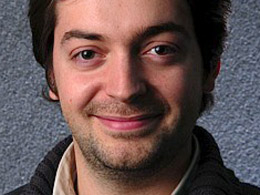Please meet Pierre-Yves, Research Director at Inria (France) and head of the FLOWERS team.
Pierre-Yves, who are you and what do you do?

I am research director at Inria, head of the team Flowers (Inria and Ensta ParisTech). Previously, I worked for 8 years at Sony Computer Science Laboratory in Paris and Tokyo.
I study brains and machines around two questions:
- How can building robots help us to better understand humans?
- How can robots be enabled to adapt and interact naturally with humans on a life-long time span?
This questions lead me to study mechanisms like curiosity, imitation and the role of the body to generate cognition.
I also built and studied robots capable to invent their own languages, i.e. to create and share a cultural system of their own, shedding light on mechanisms of language evolution in humans. This is the topic of my new book "Aux sources de la parole", published in Sept. 2013 at Odile Jacob.
I also collaborate with artists to construct experimentations of these mechanisms accessible to the wider public, such as our recent project "Ergo-Robots" featured at exhibition "Mathématiques, un dépaysement soudain" at Fondation Cartier pour l'Art Contemporain, and realized in collaboration with moviemaker David Lynch.
Tell us a bit about one of your latest projects your were working on.
Based on technologies we experimented with during the "Ergo-Robots Experiment" (probably the first experiment ever with articulated robots that could learn, create their language and interact with visitors during 5 months), the Flowers team designed a novel humanoid robot platform called Poppy. It was designed to be easily reproducible and accessible to geeks and other academic labs in the world to experiment with. The robot includes state-of-the-art bio-inspired morphology. It is open-source and can be assembled at relatively low cost using 3D printing and off-the-shelf components. The Poppy platform enables new kinds of interdisciplinary experiments with humanoid robots. The objective is to foster the creation of a community of users changing and sharing novel 3D printed parts of the robot. This is a sneak preview, as the public release is planned only at the end of september!
What recent change, technological or social, were you surprised by? Why?
I have been (positively) surprised by the recent progress of private initiatives to revigorate spatial exploration and technologies, especially when these initiatives come from companies/personalities like Google/Paypal. The world needs projects that make humanity dream and go beyond day to day issues. Spatial exploration is such a project.
What do you do to disconnect?
This is not actually difficult, as this is an important need for me. Regular periods of complete disconnection are essential, as they foster creativity as well as focused and deeper thinking.There are also so many interesting things to do outside the world of computers and internet! Thus, I disconnect several times a week, for the entire day.
--
Thank you Pierre-Yves, we are looking forward very much to learning more about your projects at Lift with Fing in October!


